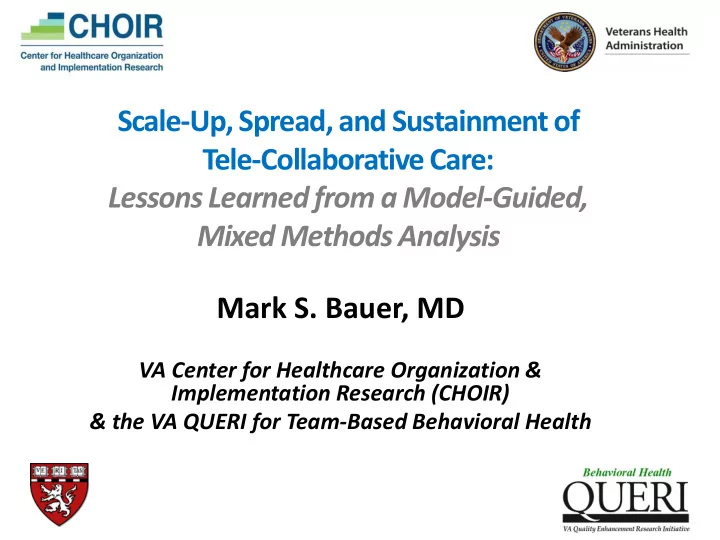

Scale-Up, Spread, and Sustainment of Tele-Collaborative Care: Lessons Learned from a Model-Guided, Mixed Methods Analysis Mark S. Bauer, MD VA Center for Healthcare Organization & Implementation Research (CHOIR) & the VA QUERI for Team-Based Behavioral Health
Public health impact for telehealth? “Telecare is characterized frequently by experimental developments that seem seldom to last beyond the trial stage. Some do not even get that far .” — May et al, JAMIA 2003 “ Telemedicine implementations often remain in the pilot phase and do not succeed in scaling-up to robust products that are used in daily practice .” — Broens et al, J Telemed & Telecare 2007
(tele)Collaborative Chronic Care Models (CCMs) • CCMs first described by Wagner and colleagues for medical illnesses. Clinical components: • Work role redesign for anticipatory care • Patient self-management enhancement • Facilitated access to expertise • Information management • Substantial evidence also shows effects in serious mental health conditions like bipolar disorder • VA health system leadership requested adaption of our bipolar CCM for clinical video teleconference delivery
Bipolar Disorder: a growing clinical concern • Almost 90,000 Veterans treated annually in VA. The number is growing steadily. • #1 cause of completed suicide in Veterans. • Suicide attempts in 1 of 50 patients treated each year. • Treatment adherence adequate in < 50% of patients. • 24% of patients hospitalized per year.
Bipolar Telehealth program elements • Based on Life Goals CCM for bipolar disorder (Bauer et al) • www.lifegoalscc.com • Funded by VACO Office of Telehealth Services 2011 • Current staffing: 2.6 MD, 2.6 psychologist virtually collaborating: • VA Boston • VA Connecticut • Bedford (MA) VAMC • VA National TeleMental Health Center at VA Connecticut provides administrative infrastructure
Bipolar Telehealth program elements • Clinical components: • Comprehensive diagnostic assessment • Psychopharmacologic consultation • Life Goals Self-Management Skills Program: Six manual-based modules covering: goals and values, mania and depression profiles and coping responses, provider visit preparation • Consult request and response via inter-facility consult in electronic health record at patient’s site • CCM delivered via videoconference from expert hub to patient’s VAMC
Bipolar Telehealth program flow Comprehensive Diagnostic One-month Life Goals Assessment & Booster Session Psychopharm Consultation to reinforce skills and update status Weekly Life Goals Booster INTAKE Sessions Typical enrollment: 4-6 months
Program evaluation aims & methods Implementation & sustainability (quantitative) • RE-AIM framework : Reach, Effectiveness, Adoption, Implementation, Maintenance → Successful implementation →Review of prospectively collected program utilization data (2011-2016) Barriers & facilitators (qualitative) • iPARIHS model: Innovation, Recipients, Context (inner & outer), Facilitation → Successful implementation →Qualitative interviews of high/low-use consulting providers (n=16)
Quantitative results: Reach
Quantitative results: Efficacy (1) (first 129 program completers)
Quantitative results: Efficacy (2) Quality measure Baseline Termination p-value Lithium use 106 (35.8%) 154 (52.0%) <0.001 Lithium level obtained (if 81 (76.4%) 114 (75.5%) 0.88 receiving lithium prescription) Antidepressant use 143 (48.3%) 103 (34.8%) <0.001 Prazosin use (if comorbid PTSD 30 (21.9%) 48 (35.0%) 0.02 diagnosis) (first 400 patients)
Quantitative results: Adoption
Quantitative results: Implementation 73.8% of consults completed via CVT 10.4 + 3.6 Life Goals 70.6% of sessions for those completers referred for Life Goals completed 3.8 + 2.6 Life Goals sessions for non- completers
Quantitative results: Maintenance • 33 of 35 sites (94.3%) still active. • For sites with 2+ years since start, consults/site increased after Year 1: median 17 30 (p<0.001).
Qualitative results (iPARIHS) • Innovation • Consult viewed as valuable clinically • Recipients • Alignment with assumed mental models of care (medications, self-management program) • Context, inner (at the sites) • Space, telehealth staff support • Champion helps • Context, outer • Nationwide emphasis on telehealth… and $. • Facilitation • National infrastructure “turnkey” operation for providers
Summary & conclusions • Linear growth of sites & patients • 1+ consult per business day since 2011 • ↑ clinical outcome & quality of care • Variable penetration across sites • Participation rates ≈ those for face -to-face Life Goals clinical trials • Program maintained in >90% of sites • Barriers and facilitators not surprising • How generalizable? • Lessons learned…
Acknowledgements Co-authors: Lois Krawczyk, PhD Aleda Franz, PhD Kathy Tuozzo, MSN Cynthia Brandt, MD Cara Frigand, MPH Meghan Rooney, PsyD Sally Holmes, MBA Jerry Flemming, MS Chris Miller, PhD Eric Smith, MD Erica Abel, PhD Linda Godleski, MD David Osser, MD Citation: • Bauer MS et al. Implementing and sustaining team-based tele- care for bipolar disorder: lessons learned from a model- guided, mixed methods analysis. Telemed & eHealth 2017; epub: PMID 28665773. 17
Recommend
More recommend